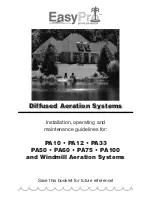
32
• Input Range
3-15 PSI
• Supply Pressure
100 PSI Max.
• Ambient Temp Limits
-40o F to 180o F
20VPR 3# INSTRUMENT PRESSURE = VALVE CLOSED
15# INSTRUMENT PRESSURE= VALVE OPEN
10VPD 3# INSTRUMENT PRESSURE = VALVE OPEN
15# INSTRUMENT PRESSURE= VALVE CLOSED
MODULATING VALVES - 20VPR AND 10VPD VALVE POSITIONERS
GENERAL SPECIFICATIONS
PNEUMATIC CONNECTIONS
The only adjustment that can be made on the
positioner is a zero adjustment. The zero adjusting
screw is located under the positioner’s top cover.
When valve shut off or opening is required at a
specific instrument pressure you will need to zero
the positioner at this point, set the instrument
air at the specific pressure and turn the zero
adjustment screw until the valve reaches the
required position.
A slight change of the instrument pressure should
start to move the valve.
• All connections are 1/4” NPT
• Recommended piping:
• 1/4” OD Instrument (input)
• 3/8” OD Supply
• Use pipe sealant sparingly on male threads
only. A non-hardening sealant is strongly
recommended.
Connect the positioner to only clean, dry, oil free
instrument air. Failure to do so will increase the
possibility of a malfunction.
Caution- Synthetic compressor lubricants in
the air stream at the instrument may cause the
positioner to fail.
The requirements for quality instrument air can
be found in the Instrument Society of America’s “
Quality Standard for Instrument Air” (ISA-S7.3).
• Particle Size: no larger than 3 microns
• Dew Point: at line pressure- should be at
least 18ºF below the minimum temperature to
which any part of the instrument air system is
exposed at any season of the year. Under no
circumstances should the dew point-at line
pressure- exceed 35.6ºF.
• Oil Content: maximum total oil or hydrocarbon
content, exclusive of noncondensibles, should
not exceed 1 PPM under normal operating
conditions.
INSTRUMENT AIR REQUIREMENTS
ADJUSTMENT
Clean, dry, oil free instrument air will reduce most
problems associated with pneumatic instruments.
If all air requirements (see above) are observed,
no routine maintenance is recommended.
MAINTENANCE
















































